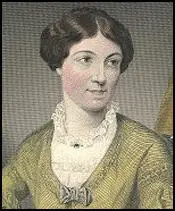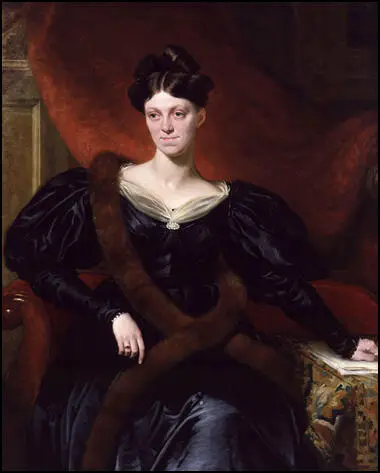Harriet Martineau

Harriet Martineau, the daughter of a textile manufacturer from Norwich, was born on 12th June 1802. Thomas and Elizabeth Martineau were Unitarians and held progressive views on the education of girls. The three girls received a similar education to their three brothers. However, where the boys were sent away to university, the girls were expected to stay at home.
Harriet thought this was very unfair and in 1823 the Unitarian journal, Monthly Repository, published her anonymous article, On Female Education. Her brother James Martineau praised it, and when he discovered that his sister was the author, said: "Now, dear, leave it to the other women to make skirts and darn stockings, and you devote yourself to this."
Harriet's father attempted to arrange for her to marry John Hugh Worthington. After some hesitation she accepted but later she changed her mind. Instead of marriage, Harriet continued writing articles for the Monthly Repository. After the death of her father in 1829, Harriet moved to London where William Fox, the editor of the journal, paid her a small wage.
As well as articles for the Monthly Repository, Harriet Martineau began to write religious books such as Devotional Exercises for the Use of Young Persons (1826) and Addresses fir the Use of Families (1826). Martineau then turned to the ambitious project of writing books on politics and economics for the ordinary reader. The material was presented as a series of stories and revealed both her passion for social reform and the influence of Jeremy Bentham and John Stuart Mill. Her book Illustrations of Political Economy (1832) was a great success and brought her financial independence. This book was followed by another bestseller, Poor Laws and Paupers Illustrated (1834).
Now a wealthy woman, Harriet Martineau, decided to spend the next two years travelling in the USA. On her return she published Society in America (1837). The book was mainly a critique of America's failure to live up to its democratic principles. Martineau was especially concerned about the treatment of women and called one chapter The Political Non-existence of Women. She claimed that women were treated like slaves. They were both "given indulgence rather than justice". Martineau argued for an improvement in women's education, so that "marriage need not be their only object in life."
In 1839 Martineau had her first novel, Deerbrook, published. It was one of the few British novels to mention the Captain Swing Riots. This was followed by The Hour and the Man (1840) based on the life of the slave leader, Toussaint L'Ouverture. The Playfellow, a volume of children's stories, was published in 1841.
Harriet Martineau moved to the Lake District in 1845 where she built herself a house near Ambleside. Her next major publication was The History of the Peace (1849) a history of England between 1816 and 1846. This was followed by Letters on the Laws of Man's Nature and Development (1851). The book created a sensation as it was a complete rejection of religious belief. The publication of the book ended her friendship with her brother, James Martineau, who was now a leading figure in the Unitarian Church.
In 1852 Harriet Martineau joined the staff of the Daily News. Over the next sixteen years she wrote over 1600 articles for the newspaper. Martineau also wrote articles on the employment of women for the Edinburgh Review and state education for girls in the Cornhill Magazine. In 1866 she joined with Elizabeth Garrett Anderson, Emily Davies, Dorothea Beale and Francis Mary Buss to present a petition asking Parliament to grant women the vote. She also wrote articles in favour of women being allowed to enter the medical profession.

An article in The Daily News in November, 1859, on the employment of women, members of the Langham Place Group, established the Society for the Promotion of the Employment of Women (SPEW). They enlisted the support of Anthony Ashley Cooper, the Earl of Shaftesbury, who became the society's first president, and other members of the National Association for the Promotion of Social Science.
In 1869 Martineau began writing articles for the Daily News attacking the Contagious Diseases Acts. These acts had been introduced in the 1860s in an attempt to reduce venereal disease in the armed forces. Martineau objected in principal to laws that only applied to women. Under the terms of these acts, the police could arrest women they believed were prostitutes and could then insist that they had a medical examination. She helped form the National Association for the Repeal of the Contagious Diseases Act. Later Josephine Butler was to become the leading figure in this organisation, but she admitted that it was Martineau who got the campaign going.
Martineau had always suffered from poor health. Between 1839 and 1844 she had been forced to live as a complete invalid. Although she recovered, by the 1870s she had to bring an end to the number of meetings and demonstrations she was attending. Harriet Martineau continued to write pamphlets and articles on women's rights until her death from bronchitis on 27th June 1876.
Primary Sources
(1) Harriet Martineau, The Daily News (17th November, 1859)
For a good many years now the subject of the independent industry of women in Great Britain has come up at shorter intervals, and with a more peremptory demand on the attention of society. From the day when the Song of the Shirt appeared there could be no doubt that the industrial condition of women would occupy attention as we see it doing now. The founding of the Governesses' Benevolent Institution, the controversies about factory employment for women, the movement in favour of women and watchwork, the opening of a few Schools of Design to women, and of an annual exhibition of pictures by them, and the successful footing they have established in various department of Art, have all pointed to the awakening of that wide interest in the subject which we witness now. The Edinburgh Review of last April contained a full narrative of the actual state of female industry in this country; and at the Social Science Meeting at Bradford, a paper read by Miss Parkes excited so much interest that the discussion has been kept up, and does not seem likely to drop at present.
Discussion about what? This is an important thing to know in a case in which so much sentiment is involved, and so much prejudice, and so much sense, and so much goodwill. What is the precise mischief to be taken in hand and what is to be done to cure it?
Miss Parkes's paper was abundantly clear and definite. She tells us the truth that a multitude of the daughters of middle-class men are neither educated nor provided for like their brothers; and that if they do not marry, they must work (unprepared by education as they are) or starve. The terms demanded on behalf of women are that parents shall either educate their daughters so as to fit them for independent industry; or lay by a provision for them; or insure their own lives for the benefit of their daughters in the day which will make them fatherless. This is very simple and clear. It is also very interesting; and, as a natural consequence, we hear of sympathy, in the form of advice and suggestions, in all directions; and of various establishments, existing or proposed, with more or less of the charitable element involved for the relief and aid of industrial women of the middle class.
Under such circumstances there must be a melancholy waste of effort, unless we ascertain betimes what it is that is wanted, and how the want may be met, with something like concert and business-like faculty. Looking at the matter from a practical point of view, the conditions of the case seem to be these.
It is supposed by persons whose attention has not been particularly called to the subject, that the women of Great Britain are maintained by their fathers, husbands, or brothers. It was once so; and careless people are unaware that we have long outgrown the fit of that theory of female maintenance. It has been out at elbows at least since the war which ended with Waterloo. From the last Census Report we learn how things were eight years ago-before the last war which has much increased the tendency of women to maintain themselves. In Great Britain, without Ireland, there were in 1851 six millions of women above twenty years of age. More than half of these work for their living. Does this surprise our readers? If it never occurred to them before, they will be still further impressed by the fact that two millions of women, out of the six millions, are independent in their industry-are selfsupporting, like men. So far is the theory of women being maintained by their male relatives from being now true. But how do these women work? and how far do they succeed in maintaining themselves? for it is universally understood that women are paid less than men for the same kind and degree of work. Society has been a good deal surprised by the disclosures in the Divorce Court of the amount of effectual female industry, proved by applications for protection of earnings from bad husbands. That women should maintain themselves and their children seems a matter of course when they are unhappily married; and the revelation has caused a good many people to perceive that there is a good deal going on in middle-class life which they were unaware of. It may strike some observers that the matter has far outgrown the scope and powers of charitable societies, and that the independent industry of Englishwomen has become a fact which must be
recognised by the law, and which must itself essentially modify middle-class education throughout the kingdom.

